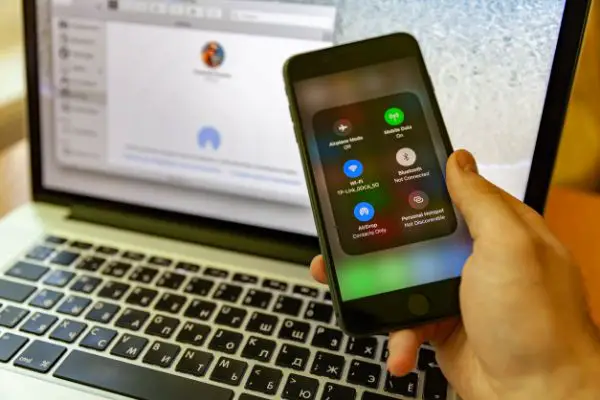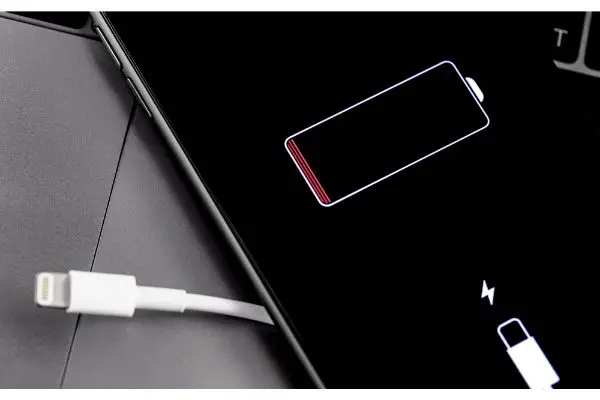Disclaimer: This post may contain affiliate links, meaning we get a small commission if you make a purchase through our links, at no cost to you. For more information, please visit our Disclaimer Page.
While Airdrop may constitute minimal battery drain, the impact shouldn’t be noticeable. The feature works on Wi-Fi and Bluetooth, two technologies that you almost certainly have on all the time. If you already use the internet and Bluetooth headsets, Airdrop shouldn’t drain any more battery.

(Attribution: ©ahilfoto/123RF.COM)
Table of Contents
Does Airdrop Drain Your Battery?
First off, it’s important to clarify that everything you do on your iPhone drains your battery. While some are harder on your battery than others, everything will take a toll on your battery, even leaving it idle.
With that said, you shouldn’t be surprised if your battery goes down a few percentage points while using Airdrop. However, if you’re getting a massive battery drain, you may want to check if something fishy is going on.
If you constantly leave Airdrop enabled on your device, you’re in for a battery drain. Depending on the specific model of iPhone you’re carrying, the level of the drain should range from “not a problem” to “worrisome.”
Even if you leave Airdrop constantly turned on, it shouldn’t have a noticeable impact on your battery life. If it does, your phone might be having unrelated issues with the battery.
Before going on to explain some of the other issues that might be draining your battery, it’s important to learn why Airdrop could be draining your battery in the first place.
Airdrop works by initiating a connection through Bluetooth, which explains why you can’t Airdrop files to someone from over 10 meters away. Bluetooth drains a subtle amount of battery, but nothing noticeable. If you use Airpods or a smartwatch, there’s a high chance that you never turn it off anyway.
Once Airdrop makes a connection using Bluetooth, it proceeds to send the files over Wi-Fi. While this makes the process quite speedy, Wi-Fi is more of a battery hog than Bluetooth.
What makes the battery drain insignificant is that your Bluetooth is constantly on, and so is your Wi-Fi for the most part. Unless you’re transferring gigabytes worth of files every hour, leaving Airdrop on shouldn’t have any noticeable effect on your battery life.
Is It OK to Leave Airdrop On?
As explained earlier, Airdrop doesn’t use any more battery than your iPhone will without it. From multiple anecdotes and lab-controlled tests, leaving Airdrop on has shown no noticeable effect on an iPhone’s battery life.
If your battery is constantly draining when you turn on the Airdrop feature, it’s either an unrelated problem or a bug. Airdrop doesn’t use anything that isn’t already constantly activated on your iPhone, explaining why it makes no difference.
Everyone connects to Wi-Fi to access the internet. If you’re Airdropping a file to someone, you don’t even need to manually turn on your Wi-Fi, as it’s on already, and the same goes for Bluetooth, in most cases at least.
Unless you’re someone who still uses a wired headphone with their iPhone, your Bluetooth should always be on all the time. Leaving your Bluetooth active won’t magically destroy your battery, and it’s even lighter on the battery than Wi-Fi.
Summarily, leaving Airdrop on is okay, and it’s even recommended for all iPhone users. You don’t want to always dig into the settings each time you need to send or receive a file using Airdrop.
If you think Airdrop is draining your battery, it usually isn’t. Read through the next section to get suggestions on how you can prevent battery drain on your iPhone, supposedly from using Airdrops.

(Attribution: ©[Primakov]/Depositphotos.com)
How to Improve Your iPhone’s Battery Life
When reading through most battery conservation tips on the internet, you’ll see people advise you to disable Airdrop, like it would have a magical effect on your battery life. The fact is that it won’t. If your iPhone’s battery is terrible, Airdrop should be one of your smallest worries.
In this section, you’ll learn how to find out what might have gone wrong with your iPhone’s battery, as well as how to fix it. Here are some suggestions to help improve your battery life on an iPhone.
Disable Background App Refresh
Most of the things that jeopardise your iPhone’s battery life run in the background. While it may appear like Airdrop is the culprit, it’s usually some apps in the background trying to refresh their feeds with your newfound Wi-Fi connection.
Since it usually fails, they keep trying and trying, using your processing power, and hence, your battery life. This cycle will make it seem like Airdrop is causing your battery drain when it’s some unrelated app refreshing in the background.
Fortunately, there’s a way to make them stop. To combat this very problem, Apple offered an option to let you disable background app refresh in iOS. Turning off background app refresh will prevent unnecessary processes from running in the background, conserving your battery life.
To turn off background app refresh on your iPhone, follow the steps below.
- Open the Settings app on your iPhone.
- From the “General” tab, find “Background App Refresh.”
- Tap the toggle on the Background App Refresh option to turn it off. There are also options to only refresh apps using Wi-Fi in the background, but you shouldn’t enable that too.
If disabling background app refreshes solved the problem, you may have to dig deeper to find the app causing the problem. If it’s not a very essential app, you can remove it from your iPhone completely.
Turn off your location services.
While Airdrop needs Wi-Fi and Bluetooth to function, it doesn’t need you to keep your location services on. If you have an app constantly trying to figure out your location, it may also be a source of a passive battery drain.
You can easily avoid this by turning off location services, and since you can always enable it each time you need to use it, there’s no reason to have it keep draining your battery.
You can turn off your location services by going to the Settings app on your iPhone and selecting the Privacy option. From the privacy options, you can select Location Services to see all the apps using your location.
Turn off the toggle on Location Services at the top of the interface to disable anything that has to do with location tracking on your iPhone. There are more subtle ways to go about it, but this should work just fine.
Adjust your screen’s brightness settings.
While the location services on your iPhone might be a battery hog, your phone’s screen still consumes most of your battery life. iPhones use excellent, bright screens, and it takes a lot of battery power to light up all the pixels required to make them look gorgeous.
If you crank your brightness levels to the maximum, you’ll be forcing your screen to work harder than it needs to, and it’s even unhealthy for your eyes.
You can dim your phone’s screen to save battery power. Alternatively, you can turn on dark mode, which reportedly uses less battery and is better for your eyes. If you hate dark mode and dim screens, you may want to find some happiness with the built-in auto-brightness feature.
Enable the Low Power Mode.
If you want to lower your brightness, disable background refresh, and do almost all battery-saving tips on autopilot without having to jump through the settings, you can simply enable the Low Power Mode.
The Low Power Mode helps to conserve your battery by applying several settings that have been proven to help conserve your iPhone’s battery.
Your iPhone will ask you to switch to Low Power Mode once your phone’s battery diminishes to 20% and 10%. However, you can also enable this mode in your settings by going to the Battery options.
You may also want to enable airplane mode if you’re in an area with poor coverage. The process of trying to stay connected can go pretty hard on your battery, which isn’t what you want if Airdrop is already messing with your iPhone’s battery.
